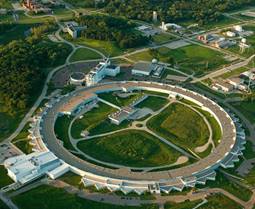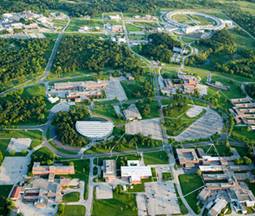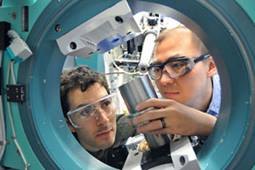Argonne: Discovery on a Mission
 Photo courtesy of Argonne National Laboratory
Photo courtesy of Argonne National Laboratory
The Advanced Photon Source at the U.S. Department of Energy's Argonne National Laboratory
This is the second installment of our monthly series spotlighting the efforts at our national labs. Argonne National Laboratory continues to deliver on its mission to address the scientific challenges of our nation through research and discovery. Find out more about the efforts and successes of America's first National Laboratory.
From its beginnings, Argonne National Laboratory has achieved ground-breaking discoveries in basic science—discoveries shaped and inspired by its fundamental mission of powering American technological progress. Argonne's history reaches back to the Manhattan Project, America's massive World War II effort to create and control nuclear reactions and develop an atomic weapon. In 1946, Argonne was founded as America's first national laboratory, dedicated to developing new ways to harness the atom and develop affordable, plentiful sources of energy. Today, Argonne's world-class researchers continue to deliver on their mission of discovery science aimed at solving the grand scientific challenges of our time.
Argonne, located near Chicago, draws on its location in the center of America's innovation heartland to create cross-disciplinary "dream teams" of world-class researchers working alongside experts from industry, academia and other government laboratories. At Argonne, materials scientists and chemists are working together with nanoscientists to develop new catalysts, solar cells, and biofuels that may help to transform our national energy economy. Scientists and engineers from diverse disciplines are working to create advanced energy storage platforms that could enable a smart energy grid, improving America's ability to store energy generated by renewable sources and improve our energy independence. Nuclear engineers and scientists are collaborating with computer scientists to develop and validate advanced modeling and simulations that will lead to safe, innovative nuclear energy systems.
 Photo courtesy of Argonne National Laboratory
Photo courtesy of Argonne National Laboratory
Aerial view of Argonne National Laboratory’s campus, located on 1,500 acres surrounded by forest just outside of Chicago.
Critical to these cross-disciplinary collaborations are Argonne's suite of state-of-the-art scientific facilities, which attract more than 5,000 researchers from around the globe each year. Funded by DOE's Office of Science and managed by UChicago Argonne, LLC, the Laboratory houses some of the nation's largest and most powerful tools for discovery science, including the Advanced Photon Source (APS)—one of the most technologically complex machines in the world. The APS offers the brightest x-ray beams in the western hemisphere, making it possible for researchers to master hierarchical structures through x-ray imaging and to study real materials under real conditions in real time.
At Argonne, scientists and engineers can integrate results from multiple user facilities to undertake research projects that would not be possible in other research settings. For example, researchers at Argonne's Center for Nanoscale Materials can integrate nanoscience with synchrotron X-ray studies, electron microscopy and high performance computing to make revolutionary advancements in materials discovery and synthesis. By discovering new ways to predict, understand and control where and how to place individual atoms and molecules to achieve desired material properties, nanoscientists hope ultimately to design new materials with useful new properties, and to build those materials one atom at a time. The knowledge these teams of researchers gain through Argonne's scientific facilities promises to have real and positive impact on energy technologies, pharmaceuticals, transportation systems, and to transform our fundamental understanding of the materials that make up our world.
 Photo courtesy of Argonne National Laboratory
Photo courtesy of Argonne National Laboratory
Scientists conduct innovative research at Argonne's Advanced Photon Source.
Argonne's scientists have won worldwide acclaim for their research on the nation's most pressing problems of energy production, storage, transmission, and use. The battery that powers the Chevy Volt, the first mass-produced plug-in hybrid electric car, uses breakthrough materials developed at Argonne. Building on this record of success, researchers in the Laboratory's energy storage program are addressing fundamental gaps that remain in our understanding of the atomic- and molecular-level processes that govern the operation, performance, and failure of batteries and supercapacitors. Increased understanding of these basic processes will lay the foundation for future generations of batteries with enhanced capacity, power, safety and longevity. Collaborative teams of Argonne researchers also are working to improve the efficiency of coal and biomass fuels by studying chemical conversions found in nature, seeking catalysts that could reduce carbon dioxide emissions and transform yard clippings and wood chips into plentiful and affordable fuels. In Argonne's solar energy program, scientists are expanding their understanding of solar energy, work that may lead to solar-fuel and solar-electric devices and systems that are efficient, scalable and economically competitive with fossil energy sources in use today.
To address the grand challenges of climate science, Argonne researchers are investigating the complex biological and environmental processes that govern the atmosphere, the earth, and the interactions between them. Argonne's excellence in chemical and molecular science plays a vital role in understanding how soil captures and releases carbon and water at the molecular level. Other environmental research looks at the vast array of interactions between earth, water, atmosphere, and living organisms, seeking to increase the accuracy of regional climate models and help us to better understand the world around us.
 Photo courtesy of Argonne National Laboratory
Photo courtesy of Argonne National Laboratory
The 10-petaflops IBM Blue Gene/Q supercomputer, named "Mira," will be delivered in 2012 and made available to scientists from industry, academia, and government research facilities around the world.
These complicated models will gain additional power when the Argonne Leadership Computing Facility launches Mira, one of the world's fastest supercomputers, with the capacity to make 10 quadrillion (10,000 trillion) calculations per second. To put that supercomputing power in perspective, if every man, woman and child in the United States performed one calculation every second, it would take them almost a year to do as many calculations as Mira will do in a single second. Mira will be used to stoke economic growth and improve U.S. competitiveness by helping researchers to design safer and more efficient combustion engines, model cellular-scale biological processes to understand health issues like Parkinson's disease, and study nuclear physics reactions of critical importance to neutrino detector and accelerator experiments. Mira also will offer new capabilities to Argonne scientists who are pursuing new knowledge of the cosmos and of the fundamental particles that make up the universe.
Argonne was originally founded on the discoveries of world-class scientists focused on a top-secret wartime mission. Today, there is no secrecy about the mission that inspires Argonne's exceptional researchers; they work each day to create new scientific knowledge that has the potential to advance our nation and change our world.
Argonne is funded by DOE's Office of Science. For more information on the Office of Science, visit www.science.energy.gov.
This article was submitted by Argonne National Laboratory


